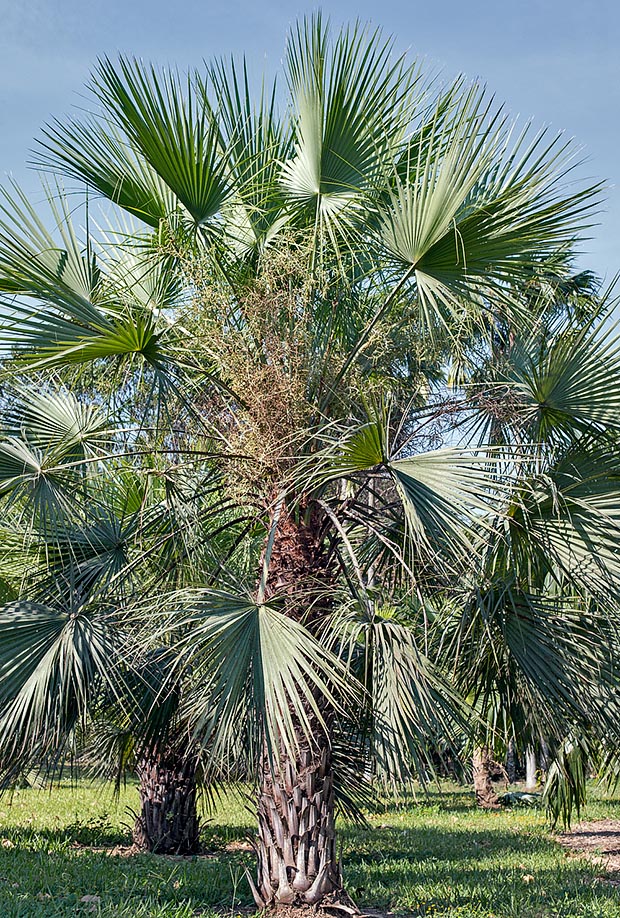Family : Arecaceae

Text © Pietro Puccio

English translation by Mario Beltramini
The species is native to the arid zones of western Mexico (Durango, Sinaloa and Sonora), where it grows in the open forests on rocky soils, often near to small water streams, up to about 1300 m of altitude.
The genus is dedicated to the Danish astronomer Tycho Brahe (1546-1601), the specific name is the Latin adjective “aculeatus, a, um” = aculeate, with reference to the stings present at the margins of the petiole.
Common names: aculeata fan palm, hesper palm, Sinaloa hesper palm (English); palmilla, ta’aco, tajcù (Mexico).

Brahea aculeata is a small-sized, undemanding species that deserves greater horticultural diffusion © Giuseppe Mazza
Brahea aculeata (Brandegee) H. E. Moore (1980) is a single stem species, 2-9 m tall, but usually not exceeding the 6 m, with a diamater of 15-25 cm, of blackish brown colour usually covered by the persistent dried leaves. Costapalmate leaves, 50-90 cm long and 0,6-1,2 m broad, of glaucous green colour, at times more intense below, divided by two thirds of the length in thin rigid segments, bifid at the apex. Petiole 0,5-1 m long and about 2 cm broad in the median part, with margins having spines irregulary arranged, 1-5 mm long, often reduced in number and size towards the apex. Inflorescences between the leaves, shorter or slightly longer than the same, with ramifications of the second order, bearing hermaphroditic flowers of white colour and intensely fragrant with 6 stamina. Globose fruits, of 2-3 cm of diameter, of glossy black colour when ripe, containing only one globose seed of 1,5-2 cm of diameter.
It reproduces by seed, placed in draining loam maintained slightly humid, that germinates with bottom heat in 1-3 months.
Palm of contained size, quite rare in cultivation in spite of the undoubted ornamental characteristics, particularly suitable for rocky gardens of desert type, cultivable in the tropical, subtropical and warm temperate zones, where it seems that can resist dry to temperatures up to about -6 °C for a very short period. Requires full sun and excellent drainage, for the rest it adapts to poor soils, alkaline, and may bear long periods of drought, but takes advantage of regular waterings, especially in the juvenile stage, in the zones characterized by long warm and dry summers; conversely, does not appreciate the excessively humid climates.
The leaves are widely utilized by the local populations as cover of the rural dwellings, resisting unaltered to the bad weather for various years, and for realizing cordages, artistic and of common use handicrafts, finally, the fruits are an important resource for the local fauna.
This species is subject to anthropogenic pressure, in particular for the intensive collection of leaves. Brahea aculeata was assessed in 2014 by the IUCN Red List of Threatened Species in the category of “LC, Least Concern”.
Synonyms: Erythea aculeata Brandegee (1905); Glaucothea aculeata (Brandegee) I.M.Johnst. (1924).
→ For general notions about ARECACEAE please click here.
